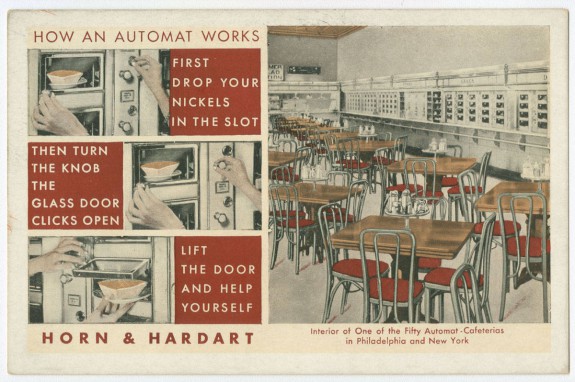The other night, I watched a charming documentary about a restaurant chain that started in Philadelphia: The Automat, founded by Horn & Hardart in 1902. Gone and forgotten long before my time, the film was an entertaining look at the rise and fall of a cultural institution.
You might see these places in movies set between 1920 and 1960. Most recently, the Amazon show Marvelous Mrs. Maisel built an automat set for their Season 5.
Factually, it was a “waiterless” restaurant, open 24 hours a day, with glorious art deco and stained glass effects. The tables were made of marble. It was a place of equality and community where anyone could show up, deposit a nickel and enjoy refreshments. They were known for certain dishes: their meatloaf, the creamed spinach, and the baked beans served in a ceramic crock. Their baked goods were of legend, and of course, their famous coffee, dispensed from a dolphin spout.
The egalitarian nature of the automat cannot be overemphasized. It had community seating and was a place where a movie star would sit at the same table as a dock worker. It wasn’t fast food, per se. It was cheap and served instantly, but the quality was high due to economies of scale.
Beyond the nostalgic taste memories of french press coffee and pie using seasonal ingredients, if there’s a lesson to the Automat documentary, it’s what can be accomplished using the cost advantages of scale. At its peak (the mid-1940s), the Automat fed hundreds of thousands of people. Horn & Hardart contracted with the US Armed Forces to cater to the ships full of soldiers headed out to war.
If it was so great, then why did it fail? Long story short, Ray Croc is what happened. Car culture gave rise to the suburbs and the drive-through. People who grew up after the Great Depression found frugality to be unstylish. The Baby Boomer generation wanted different experiences. They wanted to dress up and be served.
And the egalitarian nature of the place ran headlong into the poverty and homelessness problems of New York and Philadelphia in the 1970s. Rather than a bustling place with high turnover, Automats became refuges for the unhoused and the mentally unwell, people with nowhere else to go. The food and coffee remained of high quality, but the ambiance suffered. The company even tried to address this in ad campaigns spouting “you can’t eat ambiance.” But by the 1980s, the damage to the business model had become fatal. Without the huge crowds, the economies of scale no longer applied.
The last automat was a tourist trap in Times Square, and it closed in 1991. It marked the end of an era, the passing of what will likely be considered by historians to be the peak of American Empire. Despite the title of this post, it’s probably impossible to ever recreate the phenomenon that was the Automat. As my old football coach used to say, you can’t put the toothpaste back in the tube. But it’s fun to imagine a world where they exist, one where Ruth Bader Ginsberg, Colin Powell and Mel Brooks sat at the same table.
And while most people associate the automat with New York, let the record show it started in Philadelphia.
